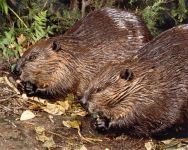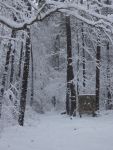Beaver Tales from Unexpected Wildlife Refuge, February 2021
Refuge sign in snow
We are in the middle of winter here at the Refuge and we just had the largest snowfall we've experienced in five years. Although some of our resident animals are out of sight hibernating, others are as active as ever. Canada geese and mallards can be seen (and heard) on Main and Miller Pond. A pair of Eagles have regularly been viewed flying over the ponds and into the surrounding treetops. White-tailed deer and cottontail rabbits are prevalent. Black vultures are often seen flying overhead, and smaller birds scurry through the underbrush. On the first morning after the snowfall, the backyard of Headquarters was very busy with a flurry of birds digging in the snow for worms and seeds. At once we saw cardinals, blue jays, robins, and sparrows, all energetically bustling about, hopping back and forth from the ground and trees; it was quite a sight.
manager@unexpectedwildliferefuge.org to schedule.
We -- and the wildlife -- are grateful for your continued support.
Contents of this month's newsletter:
News items
Bookshelves in Miller House
Miller House roof after repair
Miller House roof during repair
Miller House update
Six-Day Firearm Season week
it is tradition (traditionally and historically when people do their hunting)
it is the first opportunity to use a firearm (and first dibs at what might be available)
permits and money (only the regular firearm permit is required during this week; to hunt any other time in the season, additional permits are required)
This information serves to reinforce the importance of patrolling the Refuge during all hunting seasons, and especially during 6-Day Firearm Season week. Thank you to those of you who were able to help this season!
2017 volunteer
Annual UWR Earth Day Cleanup April 25, 2021
Beavers in the news
Here are some recent news media articles concerning beavers. You can see our entire list, a tribute to this wonderful keystone species, in our Beavers in the News page . If you come across a news item on beavers, please send us the link so that we can consider it for inclusion.
Beavers return to Dorset for the first time in 400 years -- Emer Scully
Eurasian beaver
"Their construction allows for deep pools of water which offer animals shelter from predators and a place to store food, and turns the surrounding land into a mosaic of nature-rich habitats. Beaver dams, ponds and channels help human communities too - by preventing flooding through slowing, storing and filtering water as it flows downstream."
Tallahassee beaver's misadventures end with a bubble bath -- Sandy Beck
Beaver receiving bath
"Recently, St. Francis Wildlife was called to rescue a small, adult beaver that had gotten stuck in a storm water treatment facility. The Tallahassee Fire Department, Tallahassee Animal Control and a Leon County Sheriff’s Deputy also arrived to offer back-up if needed. Yes, this is a town of animal lovers."
Campaigns for wildlife in New Jersey
White-tailed deer
Mercer County deer need you
Sea turtle
Protect our waters and wildlife from plastic waste Protect our waters and wildlife from waste
Snapshots of life at the Refuge
Common tumblebug
Common tumblebug one of nature's recyclers
White-spotted sawyer beetle
White-spotted sawyer beetle at Headquarters
Elegant spreadwing
Striking spreadwing last summer
Ant tunnel entrance
Ant tunnel entrances
More to ant mounds than meets the eye
Pearl crescent butterfly
Pearl crescent butterfly
Pearl crescent butterflies around the Refuge
Bald eagle adult bottom center
Bald eagle juvenile
Bald eagles active on our main pond
A glimpse at our past
Mary Ann and Jen
Mary Ann Gurka
Dedicated volunteer patrolling for 30 years
Headquarters in snow, 2021
Cabin in snow, 1984
Winter then and now Home page for more information and help us by donating towards our remaining debt on this project.
Beaver Tales to share with our readers!
Take action to help wildlife at the Refuge
Squirrel
Simple ways to help the Refuge
Rabbits
Helping wildlife and the Refuge in the future and wildlife . When talking with your estate planner, just provide them with our name, address and tax identification number (23-7025010 ). This is one of the most important gifts the Refuge can receive. If you have already included us in your future plans, thank you!
Take action to help animals everywhere
Here are a few of the current issues where animals can benefit from your help. We urge you to take action and share with others.
NPR Promotes Cruel "Chicken" Wings : Earlier this month, NPR’s “All Things Considered” included a segment about “chicken wings” for Super Bowl watchers. A freelance food writer was interviewed by an NPR host about how the coronavirus pandemic has affected the cost of chicken wings, and together they joked about how to eat the “wings” and so on. Near the end of the segment, the host asked her guest about “wings” for vegetarians/vegans, and the food writer said they’re available but aren’t “proper wings” – mere “faux” wings, don’t you know?
Contact All Things Considered ; Protest Show Denigrating Chickens and Encouraging Violence
Support animals everywhere by going vegan : February is "Vegan Cuisine Month". Follow the link below to learn the history of vegan cuisine, read about the honorees for each day in February, and find vegan resources including recipes, and vegan restaurants in your area.
Vegan Cuisine Month
Contact us
The team for this edition:
David Sauder, story contributor and editor
Jen Collins, story and photo contributor, and editor
Unexpected Wildlife Refuge
http://unexpectedwildliferefuge.org/
info@unexpectedwildliferefuge.org







